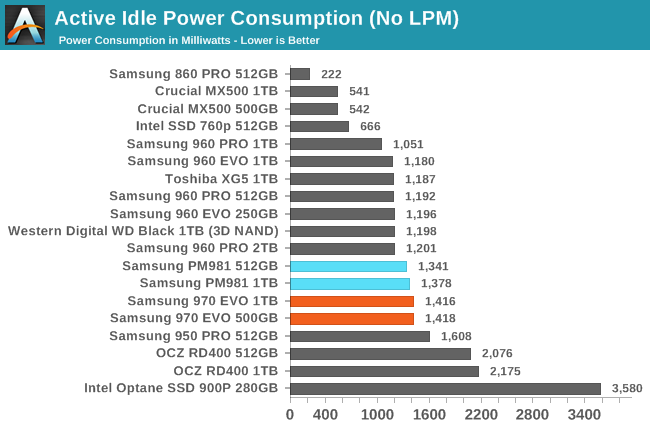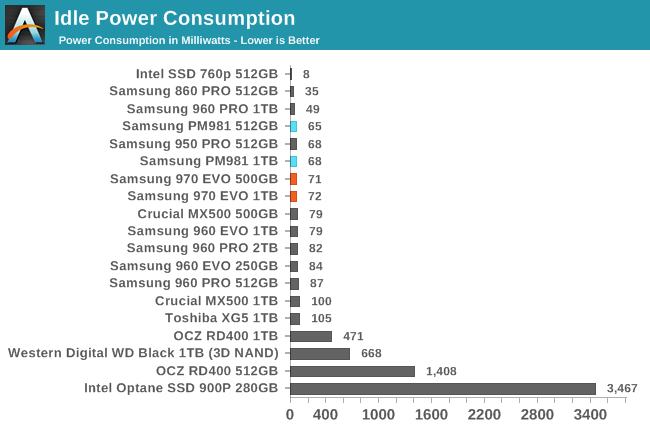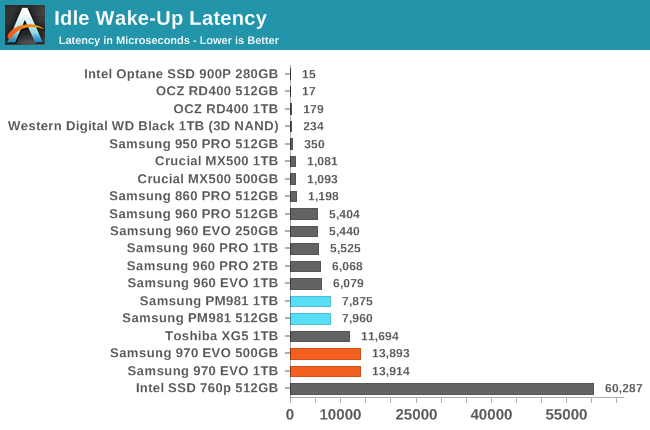The Mainstream Phoenix Rises: Samsung's 970 EVO (500GB & 1TB) SSDs Reviewed
by Billy Tallis on April 24, 2018 10:00 AM ESTPower Management Features
Real-world client storage workloads leave SSDs idle most of the time, so the active power measurements presented earlier in this review only account for a small part of what determines a drive's suitability for battery-powered use. Especially under light use, the power efficiency of a SSD is determined mostly be how well it can save power when idle.
For many NVMe SSDs, the closely related matter of thermal management can also be important. M.2 SSDs can concentrate a lot of power in a very small space. They may also be used in locations with high ambient temperatures and poor cooling, such as tucked under a GPU on a desktop motherboard, or in a poorly-ventilated notebook.
| Samsung 970 EVO NVMe Power and Thermal Management Features |
|||
| Controller | Samsung Phoenix | ||
| Firmware | 1B2QEXE7 | ||
| NVMe Version |
Feature | Status | |
| 1.0 | Number of operational (active) power states | 3 | |
| 1.1 | Number of non-operational (idle) power states | 2 | |
| Autonomous Power State Transition (APST) | Supported | ||
| 1.2 | Warning Temperature | 85°C | |
| Critical Temperature | 85°C | ||
| 1.3 | Host Controlled Thermal Management | Supported | |
| Non-Operational Power State Permissive Mode | Not Supported | ||
The Samsung 970 EVO bumps the supported NVMe spec version to 1.3, compared to the 1.2 feature set supported by the PM981 and 960 series. The 970 EVO implements the Host Controlled Thermal Management feature, allowing operating systems to configure the drive to throttle at a lower temperature than it normally would. The (optional) non-operational power state permissive mode feature is not included, so the 970 EVO is not supposed to do background tasks like garbage collection when it is in idle power states (unless they can be done within the power constraints of the idle states, which is unrealistic).
| Samsung 970 EVO NVMe Power States |
|||||
| Controller | Samsung Phoenix | ||||
| Firmware | 1B2QEXE7 | ||||
| Power State |
Maximum Power |
Active/Idle | Entry Latency |
Exit Latency |
|
| PS 0 | 6.2 W | Active | - | - | |
| PS 1 | 4.3 W | Active | - | - | |
| PS 2 | 2.1 W | Active | - | - | |
| PS 3 | 0.04 W | Idle | 0.21 ms | 1.2 ms | |
| PS 4 | 0.005 W | Idle | 2 ms | 8 ms | |
Note that the above tables reflect only the information provided by the drive to the OS. The power and latency numbers are often very conservative estimates, but they are what the OS uses to determine which idle states to use and how long to wait before dropping to a deeper idle state.
Idle Power Measurement
SATA SSDs are tested with SATA link power management disabled to measure their active idle power draw, and with it enabled for the deeper idle power consumption score and the idle wake-up latency test. Our testbed, like any ordinary desktop system, cannot trigger the deepest DevSleep idle state.
Idle power management for NVMe SSDs is far more complicated than for SATA SSDs. NVMe SSDs can support several different idle power states, and through the Autonomous Power State Transition (APST) feature the operating system can set a drive's policy for when to drop down to a lower power state. There is typically a tradeoff in that lower-power states take longer to enter and wake up from, so the choice about what power states to use may differ for desktop and notebooks.
We report two idle power measurements. Active idle is representative of a typical desktop, where none of the advanced PCIe link or NVMe power saving features are enabled and the drive is immediately ready to process new commands. The idle power consumption metric is measured with PCIe Active State Power Management L1.2 state enabled and NVMe APST enabled if supported.


Active idle power draw of the 970 EVO seems to be about 20% higher than the preceding generation of Samsung drives, but the low-power idle we measured is about the same as most other high-end NVMe drives.

The idle wake-up latency of the 970 EVO is more than twice that of its predecessors and also significantly higher than that of the Samsung PM981. This ~14ms latency exceeds the 8ms that the drive itself claims as its latency to wake up from its deepest sleep state.










68 Comments
View All Comments
PeachNCream - Tuesday, April 24, 2018 - link
That's a lot of "meh" in terms of performance for the high price.Samus - Wednesday, April 25, 2018 - link
I agree. It's basically tied with the WD Black in real world performance, but the WD Black sells for $70 less (500GB) or 40% less. That's pretty ridiculous.Reppiks - Wednesday, April 25, 2018 - link
The problem with Black is the naming, when I look in Danish shops they list 800MB/s writes so I presume thats an earlier generation? That makes it really hard to know what your buying when they dont have a WD Black 1gen, 2gen etcmoozooh - Wednesday, April 25, 2018 - link
> The problem with Black is the namingThat's racist.™
jtd871 - Wednesday, April 25, 2018 - link
I seriously can't tell if you're trying to sound clever or infantile.peevee - Monday, April 30, 2018 - link
He is succeeding at being funny. You have to be in the US context to understand why.azrael- - Thursday, April 26, 2018 - link
You need to look specifically for "NVMe" as the new WD Black SSDs are postfixed "NVMe" instead of "PCIe". For instance, a search on the ProShop site yielded five drives for "wd black nvme" of which the three were postfixed "NVMe". These are the new ones and they are *considerably* more expensive. At least a 54% markup over the old versions.FullmetalTitan - Wednesday, April 25, 2018 - link
Not sure where you are getting those price differentials from. WD Black and 970 EVO MSRPs are matched for every shared capacity.peevee - Monday, April 30, 2018 - link
newegg 1TB m.2 SSD prices:Crucial MX500 (SATA) $250
HP EX920 (NVMe PCIe x4) $360
Intel 760p (NVMe PCIe x4 )$400
WD Black (NVMe PCIe x4) $450
Samsung 970 EVO (NVMe PCIe x4) $600.
960 PRO $609.
Sams prices obviously need to CRASH before they make any sense.
https://www.newegg.com/Product/Productcompare.aspx...
Samus - Thursday, July 12, 2018 - link
https://camelcamelcamel.com/Black-512GB-Performanc...WD Black 512GB NVMe had regularly sold for $150 on sale. Until the Samsung price drops in May, the EVO 970 500GB never sold under $200, and was regularely $220-$230.
So my statement is 100% factual and correct as of the time or writing on April 25, and as of now:
"WD Black sells for $70 less (500GB) or 40% less"